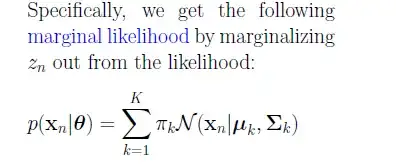The first equation, $p(\textbf{X, z} \mid \bf{\theta})$ refers to the joint likelihood function of all observed data, $\textbf{X} = x_1, x_2, \ldots, x_N$ and the latent variables, $\textbf{z} = z_1, z_2, \ldots, z_N$, given the model parameters, $\bf{\theta} \equiv \{\bf{\mu, \Sigma, \pi}\}$ hence the first equation has a product over $N$ and $K$.
The second equation refers to the likelihood of a single observation, $p(x_n \mid \bf{\theta})$. It comes from the following intuition,
Given the latent variable assignment, $z_n = k$, the given observation $x_n$ is drawn from the $k^{th}$ Gaussian component of the mixture model.
$$
p(x_n \mid z_n = k, \theta) = \mathcal{N}(\mu_k, \Sigma_k)
$$
Now, for a given observation, if you marginalize $z_n$, you get
$$
\begin{align}
p(x_n \mid \theta) &= \sum_{k=1}^{K} p(z_n = k) \times p(x_n \mid z_n = k, \bf{\theta}) \\
&= \sum_{k=1}^{K} \pi_k \times p(x_n \mid z_n = k, \bf{\theta})
\end{align}
$$
Hope that helps!

